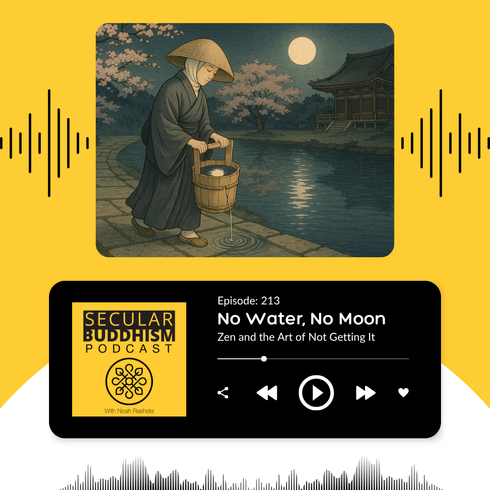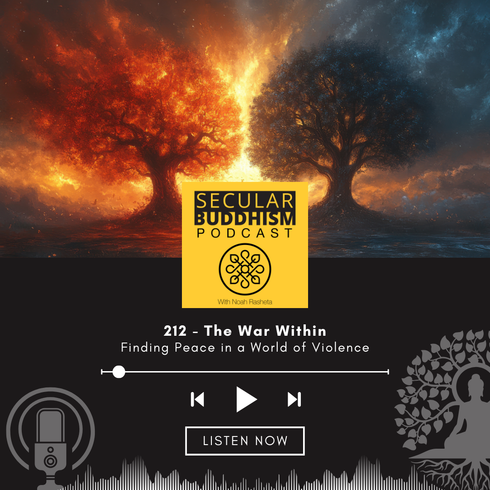According to classical Buddhist thought, “self” is a view…It is a product of our perception…and perception is always happening. What if perception is an event that occurs rather than a thing that exists? In this episode, I will talk about the 5 Skandhas / Aggregates and how this teaching can help us to loosen our grip on the sense of self we all experience.
Subscribe to the podcast on:
iTunes – https://itunes.apple.com/us/podcast/secular-buddhism/id1071578260
SoundCloud – https://soundcloud.com/secularbuddhism
TuneIn – http://tunein.com/radio/Secular-Buddhism-p823114/
Stitcher – http://www.stitcher.com/s?fid=80132&refid=stpr
New – Join our Online Weekly Sangha – https://www.remind.com/join/sbsangha
Transcription of the podcast episode:
Please excuse any typo’s, I use a transcription service to create a text version of the audio recording. If there are any issues with the transcription, please let me know.
Welcome to another episode of The Secular Buddhism podcast. This is episode #56. I am your host, Noah Rasheta and today I’m talking about: What Makes You You? (The 5 Skandhas/Aggregates) (Intro Music break 2-3 seconds).
Perception is always happening. The ongoing; stream of perceptions help us to interpret our experience of reality. This is a process that’s happening from moment to moment. Olendzki says that “perception is an event that occurs rather than a thing that exists”. We can imagine this like the still frames of a film. Each frame is unique as it’s captured, but as it’s played in our mind like a continuous film, we see this process as a cohesive narrative or story. So if we were able to pause this ongoing film that I like to call “the perception of life”, and see the individual frames, frame by frame, what would I see? And remember from the Buddhist perspective, it’s not about what we see, it’s about how do we see? This is where the teachings of the 5 aggregates comes in.
The historical Buddha taught about Five Skandhas, also called the Five Aggregates, as 5 components that come together to make an individual.
Everything that we perceive as “I” is a function of these 5 components. So try to imagine the perception you have of your “self” as a process of these 5 components.
In Buddhism
We often talk about how life is “impermanent” and “interdependent.” (the two I’s of Wisdom). Well another way of understanding interdependence is to understand that all things are “conditioned”. To be conditioned is to be dependent on or affected by something else. So in this sense, we are conditioned or dependent on other things. This allows us to pause and ask “What makes me me?” The Buddha taught that there is no independent or permanent “self”. So enderstanding the teaching of the 5 skandhas can be really helpful to seeing through the illusion of self. The sense of self that we all experience.
UNDERSTANDING THE SKANDHAS
Keep in mind that my explanation here is intended to be quite basic. The various schools of Buddhism understand the skandhas differently. As you learn more about them, you may find that the teachings of one school don’t quite match the teachings of another. You may also find that the explanation given by one school may be easier to understand than the explanation of another school. This is why it’s important to keep an open mind and to seek wisdom from various sources and approaches. Before going into each of the 5 skandhas or aggregates, I want to talk about the Buddhist view of our sense organs. If our sense of self is in fact a view…we need to understand the sense organs that make up our perceptions. In other words, how to we perceive? From the Buddhist perspective we have 6 sense organs. You’ll recognize 5 of these as the classical senses: sight, sounds, touch, smell and taste. The Buddhist view adds a 6th sense: thoughts or ideas. So we have:
Six Sense Organs and their corresponding objects:
|
1. Eye
|
1. Visible Form
|
|
2. Ear
|
2. Sound
|
|
3. Nose
|
3. Odor
|
|
4. Tongue
|
4. Taste
|
|
5. Body
|
5. Tangible Things We Can Feel
|
|
6. Mind
|
6. Thoughts and Ideas
|
THE FIRST SKANDHA: FORM/materiality (RUPA)
Form or matter; something material that can be sensed. These are essentially the 5 senses we all think about when we talk about senses: seeings, hearing, smelling, tasting, and touching. Visible form, sound, odor, taste, tangible things.
THE SECOND SKANDHA: SENSATION/Feeling Tone (VEDANA)
This is the physical or mental sensation that we experience through contact of the six faculties with the external world. In other words, it is the sensation experienced through the contact of eye with visible form, ear with sound, nose with odor, tongue with taste, body with tangible things,
mind (manas) with ideas or thoughts.
Note here that the Buddhist perspective associates the mind as a sense organ, no different than eyes or ears. Some cultures and societies tend to think of the mind is something beyond sense organ, like a spirit or soul, but that concept is out of place in Buddhism. From the Buddhist perspective, the mind is just another sense organ.
The feeling tone aspect of the senses are associated to how we experience pleasure, pain, or neutrality (neither pleasure nor pain). The feeling tone we experience through our senses will condition craving (we want more of it), or aversion (we want to avoid having that experience again). Think about this with each of the 6 senses.
THE THIRD SKANDHA: PERCEPTION (SANNA)
This is the faculty that recognizes. Most of what we call “thinking” fits into this aggregate.
This is the aggregate of the knowledge that puts together the picture. It makes meaning. It is the capacity to conceptualize and recognize things by associating them with other things. For example, we recognize dark hallways and eerie music with a feeling of being scared because we associate those things with things in the past (like a scary movie).
When we see something for the first time, we start scanning our memories and we try to find anything that might be associated with what we are perceiving. If we don’t have an index card in the library of our mind, then we may just associate the perception with it’s context…For example, I perceive this apparatus in front of me to be a car part, because I’m seeing this while standing at the mechanics auto shop and there is a car being fixed there.
THE FOURTH SKANDHA: MENTAL FORMATION/thought processes (SAMSKARA, OR IN PALI, SANKHARA)
This is where we find the biases and prejudices, the interests and attractions that arise in our thought processes and it affects our perceptions. In other words, this aggregate affects the other aggregates too. For example, stinky cheese. Why do some like it and others not? What mental formations or though processes are affecting the perception we have at that moment? So the mind always precedes the mental states we are experiencing.
THE FIFTH SKANDHA: CONSCIOUSNESS/awareness (VIJNANA, OR IN PALI, VINNANA)
This is essentially the reaction or the emotional response we have to the object at that moment. It applies to the six sense faculties.
For example, visual consciousness — seeing — has the eyes as its basis and what we see as its object. Audible consciousness has the ears as the basis and what we hear as the object. Mental consciousness has the mind as its basis and an idea or thought as its object. Once we are aware of this relationship between the sense organ and the object, we become aware that there is an emotional response taking place. We like it or don’t like it, we want it or don’t want it, there is a whole range of responses taking place regarding the experience we are having. Olendzki says “we never just notice an object, we engage with it emotionally”.
Our sense of self is created by the emotional responses we experience in each moment. The moment we see something, the sensation of the person who see’s emerges. Olendzski says “the self is created by our emotional responses as they unfold each moment: when we crave for an object of experience, then “the person who” wants it is constructed; when we generate aversion toward an object, then the person who hates it comes into existence.”
WHY IS THIS IMPORTANT?
The Buddha wove his explanation of the skandhas into a lot of his teachings. The most important point he made about these teachings is that the skandhas are not “you.” They are temporary, interdependent, conditioned phenomena. He taught that clinging to these aggregates as “me” is illusion.
When we realize that these aggregates are just temporary phenomena, conditioned on other phenomena, but they are “not me”, then we are on the path to enlightenment.
Whatever is not yours, abandon it.
What is it that is not yours?
Material form, feeling, perception,
formations, consciousness.
These are not yours.
When you have abandoned them,
that will lead to your welfare
and happiness for a long time. – Majjhima Nikaya 22
So back to the question of What makes you you? All these things make you you, but none of them are you. It’s like recognizing this is how I am right now, but it’s not what I am. Like the analogy of my clothes.
Challenge for this week. Observe without attachment.
If you want to learn more about this topic… check out Andrew Olendzki’s book “Untangling Self: A Buddhist Investigation of Who We Really Are”
If you enjoyed this podcast episode, please share it with others, write a review, or give it a rating in iTunes. If you would like to join our online community. Please visit
secularbuddhism.com/communityIf you would like to make a donation to support the work I’m doing with this podcast, please visit
secularbuddhism.com and click the “donate” button. That’s all I have for now, but I look forward to recording another podcast episode soon…
Until next time!
[Music]


